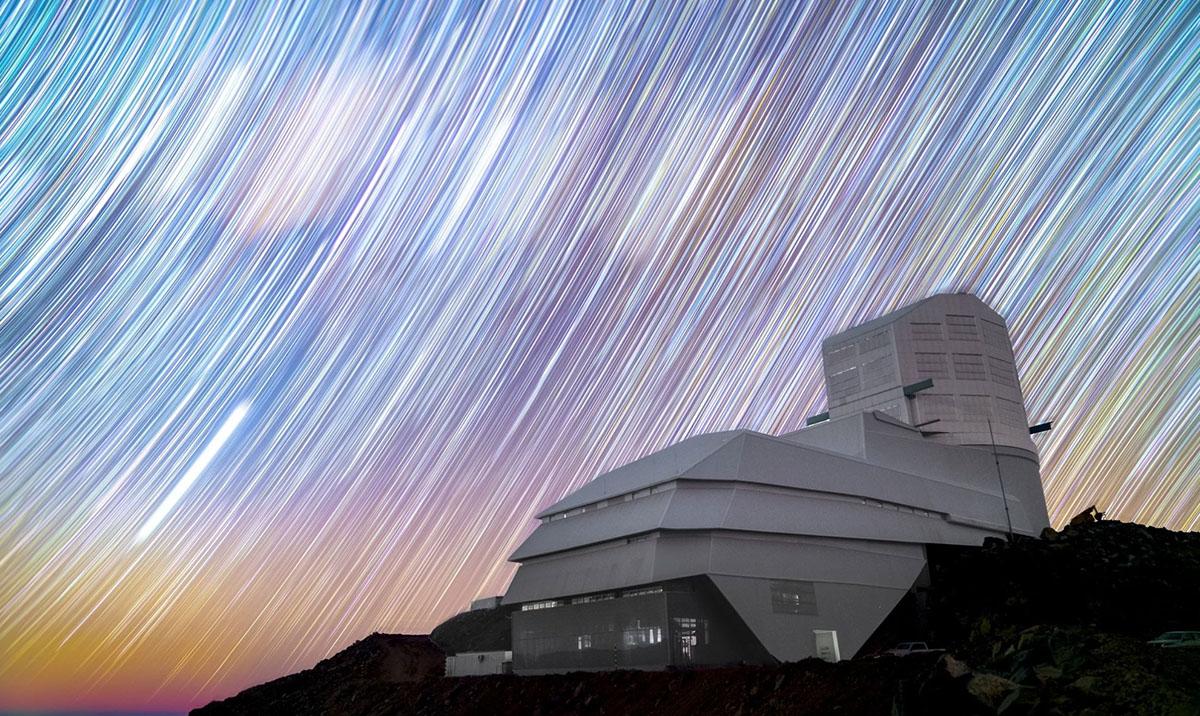Awaiting the first astronomy images from the world’s largest camera
20 June 2025
On 23 June 2025 the first images from the Vera C. Rubin Observatory will be revealed to the world in a ‘First Look’ event. A collaboration between EPCC and the University of Edinburgh's Institute for Astronomy will be central to the decade of great science that will follow.

Image: Rubin Observatory stands on Cerro Pachón in Chile against a sky full of star trails in this long exposure night sky image. Credit: Hernan Stockebrand.
Located on a mountaintop in Chile, the NSF-DOE Vera C. Rubin Observatory pairs one of the world’s biggest telescopes with the largest digital camera ever made. Over the next decade this astronomical discovery machine will conduct the Legacy Survey of Space and Time (LSST), an ultra-wide, high-definition time-lapse record of our Universe – a cosmic movie.
Rubin is unique: its mirror design, camera size and sensitivity, telescope speed, and computing infrastructure are each in an entirely new category. This combination will enable it to produce a huge dataset that will advance knowledge across astronomy, from the nearest asteroids to the most distant quasars. By repeatedly scanning the southern sky, Rubin will detect celestial sources that have moved or changed, and it will issue millions of alerts regarding such events every night for a decade.
While Rubin is a US facility, its operation will rely on contributions from researchers around the world. The UK is the second largest international contributor, with an investment of £23 million to date by the Science and Technology Facilities Council (STFC) supporting scientific and technical preparation for the LSST in the UK. These contributions will earn access to the LSST dataset by astronomers from LSST:UK, an umbrella organisation comprising all the UK’s university astronomy groups.
The University of Edinburgh plays a key role in LSST:UK, through a collaboration between EPCC and the Institute for Astronomy (IfA).
EPCC’s Advanced Computing Facility hosts the cloud computing system at the heart of LSST:UK activities. Named after Scottish mathematician and astronomer Mary Somerville, the Somerville cloud will host the UK’s Independent Data Access Centre, which will hold a copy of the multi-Petabyte LSST dataset and a range of analysis tools for extracting science from it. Somerville is also home to Lasair, an alert broker that will classify the events in the Rubin alert stream, identifying rare events like supernovae amongst the much larger population of variable stars.
IfA astronomers are also developing a range of analysis algorithms - to detect and characterise thousands of comets and asteroids and use the properties of the ten billion galaxies in the LSST to constrain the nature of the 'dark energy' believed to be causing the expansion of the Universe to accelerate – while EPCC researchers are part of the UK Data Facility, which will take a quarter of the LSST data processing workload, comprising more than 1.5 million images over the ten years of the survey.
Bob Mann, Professor of Survey Astronomy in the IfA and LSST:UK Project Leader, commented:
The arrival of the First Look images will show that the Rubin system is working well, so we can be confident that we are at the start of a decade of astronomical discovery with the LSST. I am proud that the UK is taking a key role within the international LSST community and that Edinburgh researchers are so prominent within the LSST:UK Consortium. Local expertise in a range of scientific and technical areas will secure Edinburgh a place at the forefront of the scientific exploitation of this unique dataset over the coming decade or more.
George Beckett Rubin UK Data Facility Coordinator and EPCC Programme ManagerThis is an incredibly exciting time both for astronomers and computational scientists. The scale and complexity of LSST will push what is possible in scientific computing. EPCC, with its significant pedigree in supercomputing, data-intensive research and AI is ideally placed to help the astronomy community to find the answers they seek.
First Look
Dynamic Earth in Edinburgh will host a ‘First Look Live’ event where you can join Professor Catherine Heymans, Astronomer Royal for Scotland, and expert astronomers from the University of Edinburgh to see the very first images from the Rubin Observatory. See the Dynamic Earth website for details.
Links to Rubin First Look live streams will be made available at rubinobservatory.org
Rubin First Look Watch Party website.
Further information
EPCC article: Enabling science from the Rubin alert stream with Lasair
